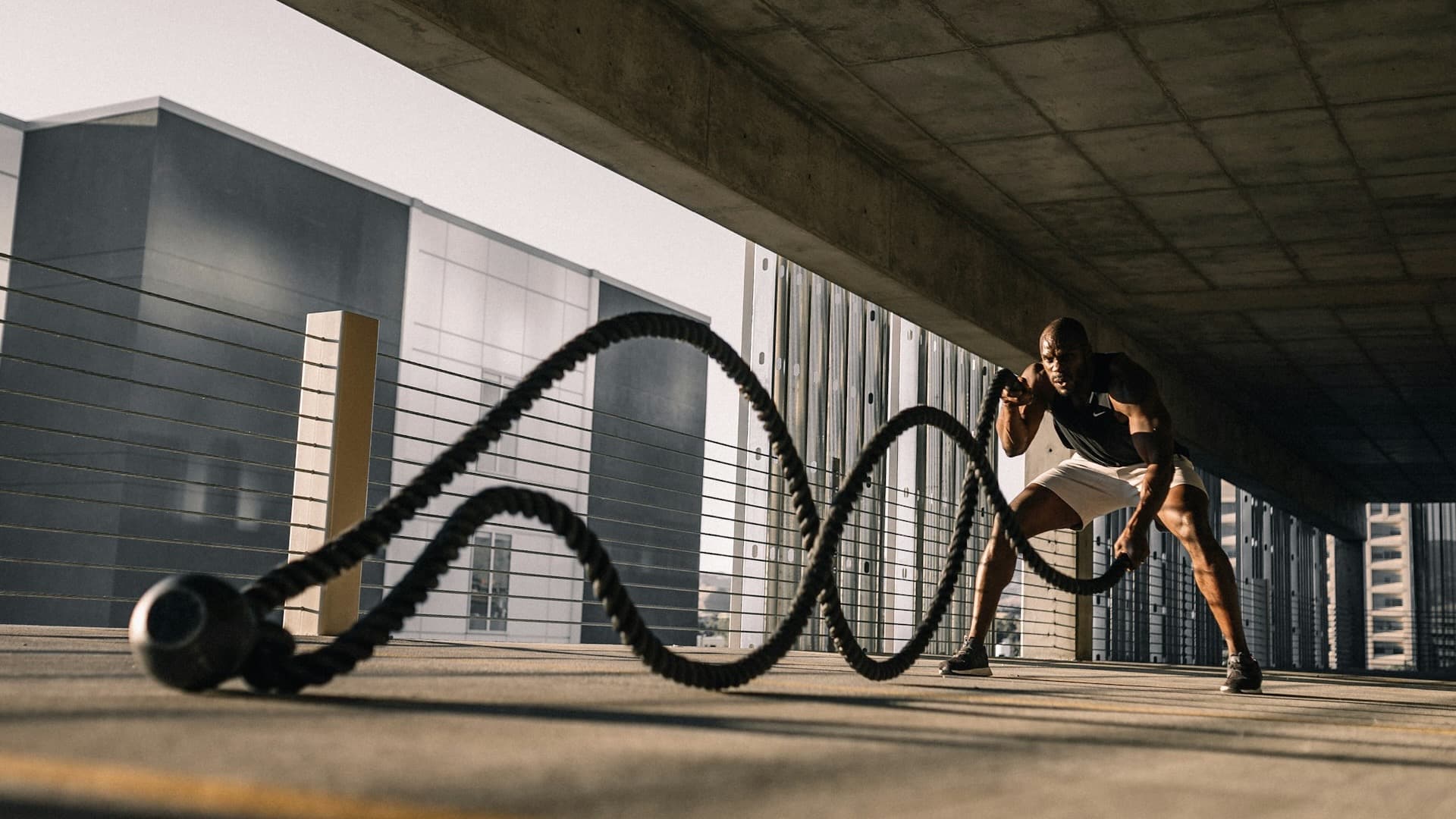
High-Intensity Interval Training
High-Intensity Interval Training (HIIT) is a mode of exercise characterized by short, intermittent bursts of vigorous anaerobic exercise alternated with brief periods of rest or low-intensity recovery [26][12].
The primary aim of HIIT is to achieve significant health and fitness benefits in a time-efficient manner, with workouts typically lasting under 30 minutes [9]. This flexible strategy can be applied to a wide range of exercises, including running, cycling, and bodyweight movements, and is adaptable to various fitness levels by adjusting the intensity, duration, and work-to-rest ratios [26][14].
High-Intensity Interval Training (HIIT) functions by subjecting the body to significant metabolic and mechanical stress, which initiates a cascade of beneficial cellular adaptations [6]. During the intense work intervals, a rapid change in the cellular energy state activates key metabolic sensors like AMP-activated protein kinase (AMPK), while forceful muscle contractions trigger a release of calcium ions, activating calcium/calmodulin-dependent protein kinase (CaMK) [6][22]. These signals, along with a transient burst of reactive oxygen species (ROS) acting as signaling molecules, converge on a master regulator called PGC-1α [6][22]. HIIT robustly increases the expression of PGC-1α, which orchestrates the creation of new and larger mitochondria—the powerhouses of the cell [15][14][9]. This process, known as mitochondrial biogenesis, enhances the body's oxidative capacity, improving its ability to use both fat and glucose for fuel [3][21].
These cellular changes translate into a wide range of validated health outcomes. HIIT is highly impactful for improving cardiovascular and cardiorespiratory fitness, often leading to greater improvements in maximal oxygen uptake (VO2 max) compared to moderate-intensity continuous training (MICT) [20]. It has been shown to reduce resting heart rate, lower blood pressure, and improve blood vessel function [20][26]. Metabolically, HIIT enhances insulin sensitivity, helps regulate blood sugar, and elevates the metabolic rate for hours after exercise, a phenomenon known as excess post-exercise oxygen consumption (EPOC) [20][29].
In terms of body composition, HIIT is effective at reducing total body fat, visceral fat, and waist circumference, while also helping to preserve or even increase muscle mass [20][26][41]. However, while it is a potent stimulus for overall fitness, it is less impactful for inducing significant muscle growth (hypertrophy) compared to traditional resistance training [20]. Furthermore, meta-analyses reveal that when total exercise volume is matched, HIIT and MICT produce similar fat loss results, indicating its primary advantage is time efficiency rather than superior fat-burning capability [16][34].
A typical HIIT program is structured by manipulating key variables like the intensity of work intervals (80-95% of max heart rate), the duration of work and rest periods, and the work-to-rest ratio [4].
Sample Beginner Bodyweight HIIT Workout: A beginner should start with a 1:2 or 1:3 work-to-rest ratio to allow for adequate recovery between efforts [26].
- Warm-up (5 minutes): Begin with dynamic movements like light jogging and leg swings to prepare the body [35].
- Workout Circuit (Repeat 3-4 times):
- Cool-down (5 minutes): Finish with static stretching to aid recovery.
Common Pitfalls:
- Improper Form: The high intensity of HIIT means fatigue can quickly lead to a breakdown in form, increasing injury risk [3]. This is a primary concern with complex movements.
- Burpees: This common HIIT exercise can place significant stress on the body. The landing phase of the jump can subject the knees to forces up to 3.5 times an individual's body weight [11][36]. Rounding the back during the transition from plank to squat can also strain the lumbar spine.
- Kettlebell Swings: This exercise generates substantial posterior shear forces on the lumbar spine, which requires significant core stability to manage safely [23][8]. The American (overhead) swing variation can further increase risk by promoting lumbar hyperextension [10].
Pros
Cons
Cardiovascular Contraindications: While generally safe, vigorous exercise transiently increases the risk of an acute cardiac event, especially in sedentary individuals [32]. There are absolute contraindications for individuals with conditions like unstable angina, severe aortic stenosis, and uncontrolled cardiac arrhythmias [31]. Medical clearance is crucial for those with pre-existing conditions [29].
Do I need a gym or fancy equipment for HIIT?
No. A major advantage of HIIT is its versatility. Challenging and effective workouts can be performed anywhere using only bodyweight exercises like push-ups, squats, and high knees [2]. This makes it a highly accessible form of exercise that does not require a gym membership or expensive equipment.
Is HIIT only for elite athletes?
No, this is a common misconception. HIIT is highly scalable, and the "high intensity" is relative to an individual's personal fitness level [33]. Beginners can start with shorter work intervals, longer rest periods, and low-impact exercise modifications. Supervised HIIT has been shown to be relatively safe and beneficial for various populations, including older adults and those in cardiac rehabilitation [17].
Is HIIT the magic bullet for weight loss?
While HIIT is an effective tool for burning calories and can contribute to fat loss, it is not a standalone solution [20]. Scientific reviews have shown that when the total amount of work is matched, HIIT and traditional steady-state cardio produce similar results for fat loss [25]. The most critical factor for sustainable weight loss is a consistent calorie deficit achieved through a combination of diet and exercise.
Should I do HIIT every day for results?
No, daily HIIT sessions are not recommended and can be counterproductive. The body needs adequate time to recover and adapt from the intense stress of HIIT. Experts generally recommend two to three HIIT sessions per week on non-consecutive days to prevent overtraining, which can lead to injury, hormonal imbalance, and burnout [13][1].
Will HIIT make me "bulk up"?
It is unlikely that HIIT will cause you to become "bulky." While it can help preserve and even build some lean muscle, particularly in those new to exercise, it is not the most effective method for significant muscle growth (hypertrophy). Traditional strength training with progressive overload remains the superior method for building substantial muscle mass [20].